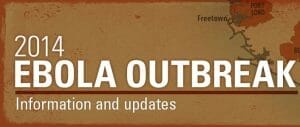
Ebola hemorrhagic fever (Ebola HF) is one of numerous Viral Hemorrhagic Fevers. It is a severe, often fatal disease in humans and nonhuman primates (such as monkeys, gorillas, and chimpanzees).
Ebola HF is caused by infection with a virus of the family Filoviridae, genus Ebolavirus. When infection occurs, symptoms usually begin abruptly. The first Ebolavirus species was discovered in 1976 in what is now the Democratic Republic of the Congo near the Ebola River. Since then, outbreaks have appeared sporadically.
There are five identified subspecies of Ebolavirus. Four of the five have caused disease in humans: Ebola virus (Zaire ebolavirus); Sudan virus (Sudan ebolavirus); Taï Forest virus (Taï Forest ebolavirus, formerly Côte d’Ivoire ebolavirus); and Bundibugyo virus (Bundibugyo ebolavirus). The fifth, Reston virus (Reston ebolavirus), has caused disease in nonhuman primates, but not in humans.
The natural reservoir host of ebolaviruses remains unknown. However, on the basis of available evidence and the nature of similar viruses, researchers believe that the virus is zoonotic (animal-borne) with bats being the most likely reservoir. Four of the five subtypes occur in an animal host native to Africa.
2014 Ebola Outbreak in West Africa
The Guinean Ministry of Health, the Ministry of Health and Sanitation of Sierra Leone, the Ministry of Health and Social Welfare of Liberia, and the Nigerian Ministry of Health are working with national and international partners to investigate and respond to the outbreak.
Signs and Symptoms
- Fever
- Headache
- Joint and muscle aches
- Weakness
- Diarrhea
- Vomiting
- Stomach pain
- Lack of appetite
Some patients may experience:
- A Rash
- Red Eyes
- Hiccups
- Cough
- Sore throat
- Chest pain
- Difficulty breathing
- Difficulty swallowing
- Bleeding inside and outside of the body
Prevention
The prevention of Ebola HF presents many challenges. Because it is still unknown how exactly people are infected with Ebola HF, there are few established primary prevention measures.
When cases of the disease do appear, there is increased risk of transmission within health care settings. Therefore, health care workers must be able to recognize a case of Ebola HF and be ready to employ practical viral hemorrhagic fever isolation precautions or barrier nursing techniques. They should also have the capability to request diagnostic tests or prepare samples for shipping and testing elsewhere.
The aim of all of these techniques is to avoid contact with the blood or secretions of an infected patient. If a patient with Ebola HF dies, it is equally important that direct contact with the body of the deceased patient be prevented.
Homoeopathic Medicines in Ebola Outbreak
CROTALUS HORRIDUS is a homeopathic cure for Ebola Virus at 30C dilution according to reliable sources.
As a preventative if an outbreak happens nearby, Crotalus horridus 30C, one dose daily, until the threat is out of the area is the method.
If a person is infected, the remedies most commonly used would be the following.
One dose every hour, but as the severity of the symptoms decrease, frequency is reduced. If no improvement is seen after 6 doses, a new remedy ought to be considered.
Crotalus horridus 30C – Is to be considered for when there is difficulty swallowing due to spasms and constriction of the throat, dark purplish blood, edema with purplish, mottled skin.
Bothrops 30C – Is the remedy to think of when nervous trembling, difficulty articulating speech, sluggishness, swollen puffy face, black vomiting are present
Lachesis mutus 30C ,– when there’s delirium with trembling and confusion, haemorrhage in any area, consider this remedy. Often, the person cannot bear tight or constricting clothing or bandages and feels better from heat and worse on the left side.
Research :
Sicarius (six-eyed crab spider): a homeopathic treatment for Ebola haemorrhagic fever and disseminated intravascular coagulation? In geographical locations prone to be affected by ebola virus, a prophylctic administration of potentised Sicarius spider will be beneficial Link

HOMEOBOOK E bola about ebola. Thanks for ebola.
Yes Crt.hrd 1m daily 1 ds fr conjcutive 4 days can be used 4 prevention .Treatment can be made with symtomtology, may be with Ars Ab,Crt Hrds, Lachs. Thnx.
this is very usefull information but symptom similarity is must for every case.
Very informative
Arsenicum Album LM potency/30 repeatedly, is also a very effective remedy in this condition.